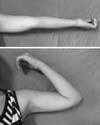Abstract
Purpose
To evaluate the clinical results of double tension band wiring for communited olecranon fractures involving proximal 1/3.
Materials and Methods
We reviewed 9 cases of communited olecranon fractures involving proximal 1/3 treated with double tension band wiring followed for minimum 10 months. There were 2 cases of olecranon fractures involving only proximal 1/3, 6 cases of olecranon fractures involving from proximal 1/3 to middle 1/3 and 1 case of olecranon fractures involving from proximal 1/3 to distal 1/3. We analyzed the bone union time, radiologic results for gap, reduction loss, pin migration, pain, range of motion, complications and functional outcomes at last follow up.
Results
All patients had solid bone union without additional surgery and average union time was 10.3 weeks. Anatomical reduction could be obtained in 8 of 9 cases but there was 1 mm step off in one case. 36 pins were used to fix the fractures, 1 pin of 18 distal pins and 2 pins of 18 proximal pins were migrated to backward but there was no reduction loss. Only 1 distal pin needed early removal due to skin irritation. Average range of motion ranged from flexion contracture 3.3° to further flexion 137.8°. On functional analysis, we got 8 cases of good result, 1 case of fair result and there was no poor result.
Figures and Tables
 | Fig. 1Classification of olecranon fracture.Type I: Olecranon fracture involving only proximal 1/3.
Type II: Olecranon fracture involving from proximal 1/3 to middle 1/3.
Type III: Olecranon fracture involving from proximal 1/3 to distal 1/3.
|
 | Fig. 2(A) Initial radiographs depicted the intraarticular communited fracture of proximal olecranon (type II).
(B) Immediate postoperative radiographs showed anatomical reduction with double tension band wiring.
(C) Radiographs of postoperative 9 months demonstrated the excellent congruence of the elbow joint.
|
References
1. Coonrad RW. The elbow. Master techniques in orthopaedic surgery. In : Morrey BF, editor. Management of olecranon fractures and nonunion. 1st ed. New York: Raven Press Ltd;1994. p. 71–95.
2. Fyte IS, Mossad MM, Holdsworth BJ. Methods of fixation of olecranon fractures. An experimental mechanical study. J Bone Joint Surg Br. 1985; 67:367–372.
3. Helm RH, Hornby R, Miller SW. The complications of surgical treatment of displaced fracture of the olecranon. Injury. 1987; 18:48–50.

4. Macko D, Szabo RM. Complications of tension-band wiring of olecranon fractures. J Bone Joint Surg Am. 1985; 69:1396–1401.

5. Matter P, Scharplatz D. Fractures and dislocation of the Elbow. Operative orthopedics. 2nd ed. Philadelphia: J.B. Lippincott Co;1988. p. 253–262.
6. Morrey BF. Current concepts in the treatment of fractures of the radial head, the olecranon and the coronoid. Instr Course Lect. 1995; 44:175–185.

7. Muller ME, Allgower M, Schneider R, Willenegger H. Manual of internal fixation. 3rd ed. Berlin: Springer-Verlag;1991. p. 44–45.
8. Park SW, Hur CY, Shim JH. Operative treatment of olecranon fracture. J Korean Soc Fract. 1994; 7:58–64.

9. Shin HD, Rhee KJ, Lee JK, et al. Operative treatment of olecranon fractures using tension band wiring. J Korean Soc Fract. 1998; 11:672–682.

10. Weber BG, Vasey H. Osteosynthesis bin olekranon fraktures. Z Unfallmed Berufskr. 1963; 56:90–96.




 PDF
PDF ePub
ePub Citation
Citation Print
Print







 XML Download
XML Download